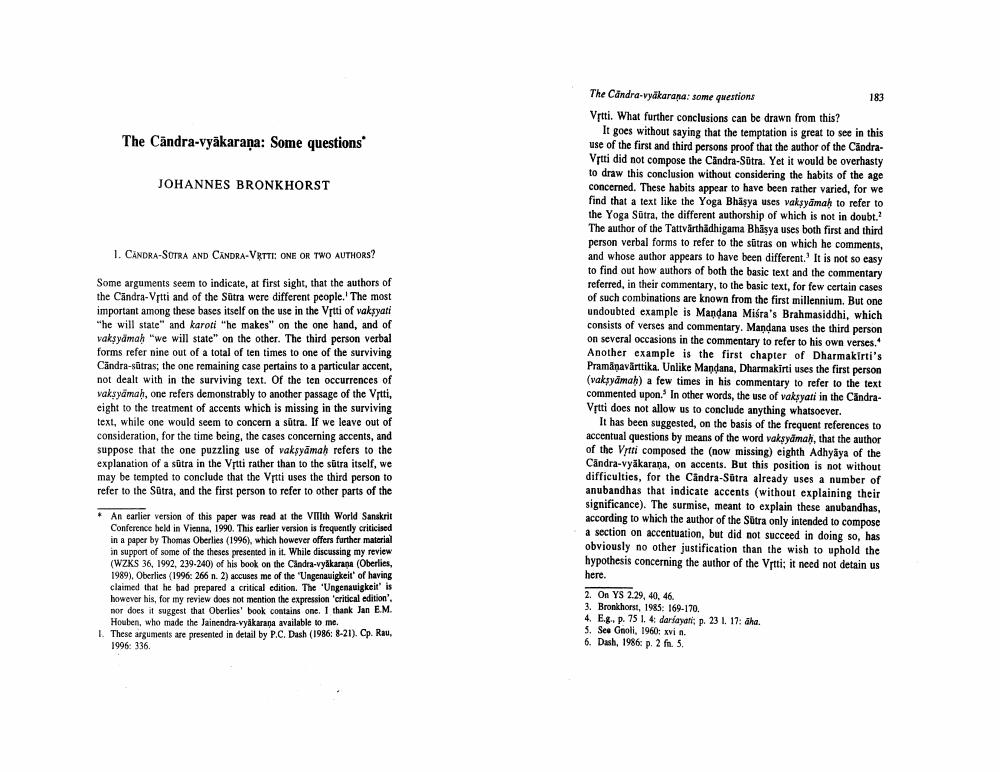Book Title: Candra Vyakarna Some Questions Author(s): Johannes Bronkhorst Publisher: Johannes Bronkhorst View full book textPage 1
________________ 183 The Candra-vyäkaraņa: Some questions JOHANNES BRONKHORST 1. CANDRA-SUTRA AND CANDRA-VRTTE: ONE OR TWO AUTHORS? Some arguments seem to indicate, at first sight, that the authors of the Cändra-Vrtti and of the Sūtra were different people. The most important among these bases itself on the use in the Vrtti of vaksyati "he will state and karoti "he makes" on the one hand, and of vaks yamah "we will state" on the other. The third person verbal forms refer nine out of a total of ten times to one of the surviving Cândra-sūtras; the one remaining case pertains to a particular accent, not dealt with in the surviving text. Of the ten occurrences of vaks yamah, one refers demonstrably to another passage of the Vrtti, eight to the treatment of accents which is missing in the surviving text, while one would seem to concern a sutra. If we leave out of consideration, for the time being, the cases concerning accents, and suppose that the one puzzling use of vaksyāmah refers to the explanation of a sūtra in the Vrtti rather than to the sutra itself, we may be tempted to conclude that the Vrtti uses the third person to refer to the Sutra, and the first person to refer to other parts of the The Candra-vyakarana: some questions Vrtti. What further conclusions can be drawn from this? It goes without saying that the temptation is great to see in this use of the first and third persons proof that the author of thi Vrtti did not compose the Cāndra-Sūtra. Yet it would be overhasty to draw this conclusion without considering the habits of the age concerned. These habits appear to have been rather varied, for we find that a text like the Yoga Bhasya uses vaksyāmah to refer to the Yoga Sötra, the different authorship of which is not in doubt.2 The author of the Tattvärthadhigama Bhäsya uses both first and third person verbal forms to refer to the sutras on which he comments, and whose author appears to have been different. It is not so easy to find out how authors of both the basic text and the commentary referred, in their commentary, to the basic text, for few certain cases of such combinations are known from the first millennium. But one undoubted example is Mandana Misra's Brahmasiddhi, which consists of verses and commentary. Mandana uses the third person on several occasions in the commentary to refer to his own verses.' Another example is the first chapter of Dharmakirti's Pramanavärttika. Unlike Mandana, Dharmakirti uses the first person (vaksyamah) a few times in his commentary to refer to the text commented upon. In other words, the use of vaksyari in the CandraVrtti does not allow us to conclude anything whatsoever. It has been suggested, on the basis of the frequent references to accentual questions by means of the word vaksyamah, that the author of the Vitti composed the (now missing) eighth Adhyâya of the Candra-vyākarana, on accents. But this position is not without difficulties, for the Candra-Sutra already uses a number of anubandhas that indicate accents (without explaining their significance). The surmise, meant to explain these anubandhas, according to which the author of the Sutra only intended to compose a section on accentuation, but did not succeed in doing so, has obviously no other justification than the wish to uphold the hypothesis concerning the author of the Vrtti: it need not detain us here. 2. On YS 2.29, 40, 46. 3. Bronkhorst, 1985: 169-170. 4. E.g. p. 75 1. 4 daríayati, p. 231. 17: aha. 5. Sea Gnoli, 1960: xvi n. 6. Dash, 1986: p. 2 fr. 5. * An earlier version of this paper was read at the Vitith World Sanskrit Conference held in Vienna, 1990. This earlier version is frequently criticised in a paper by Thomas Oberlies (1996), which however offers further material in support of some of the theses presented in it. While discussing my review (WZKS 36, 1992, 239-240) of his book on the Candra-vyakarana (Oberlies, 1989), Oberlies (1996: 266 n. 2) accuses me of the 'Ungenauigkeit of having claimed that he had prepared a critical edition. The 'Ungenauigkeit is however his, for my review does not mention the expression critical edition nor does it suggest that Oberlies' book contains one. I thank Jan E.M. Houben, who made the Jainendra-vyakarana available to me. 1. These arguments are presented in detail by P.C. Dash (1986: 8-21). Cp. Rau, 1996: 336.Page Navigation
1 2 3 4 5 6 7 8 9 10
